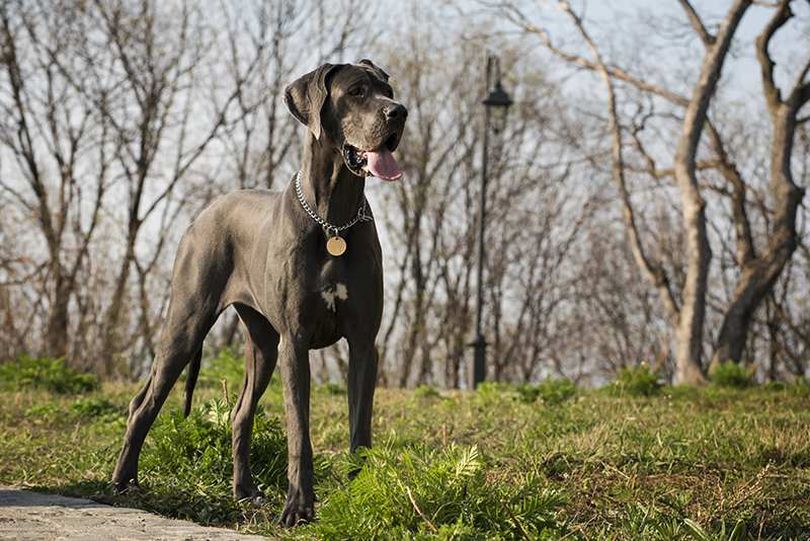Dog Breed
Great Dane
Giant

- Full Name
- Great Dane
- Your PupScore
- Take the best dog breed quiz to get your Pup Scores!
- Life Span
- 7 - 10 years
- Weight
- 110 - 190 pounds
- Description
The giant of the dog world- although calm and friendly, they are intimidating just from their pure size alone. Some believe Egyptian carvings from 3,000 BC depict the Great Dane and that it was known as both a dog of royalty and a fierce hunting companion who could take on wild boar and other animals. Although the Great Dane is still an imposing dog, it is much calmer and suited as a family dog. In fact, even though it has hunting roots, it is no longer known as an ideal hunting dog. Unfortunately, Great Danes have many potential health issues and have one of the lowest life spans of all dog breeds.
- Origin
- Germany
- Bred For
- Hunting & holding boars, Guardian
- Family Considerations
- Overall Ease of Breed
- Personality
- Home and Environment Considerations
- Physical Characteristics
Child Friendly
5/5
Is the Great Dane good with children?
Yes! The Great Dane is naturally friendly with children. As always, socialization is always important, but the Great Dane is an excellent dog for anyone with small children.
Stranger Friendly
3/5
Is the Great Dane friendly with strangers?
The Great Dane is about average in how friendly they are with strangers. They can be timid or protective, but with proper training and socialization can be fine for any household.
Dog Friendly
3/5
Is the Great Dane friendly with other dogs?
The Great Dane is about average in how friendly they are with other dogs. They can be timid or defensive, but with proper training and socialization can be fine for dog parks and living with other dogs at home.
Likes to Cuddle
3/5
Does the Great Dane like to cuddle?
The Great Dane likes to cuddle up every once in a while. They appreciate physical affection, but probably won't stay in your lap for extended amounts of time.
Playfulness
3/5
Does the Great Dane like to play?
The Great Dane is playful both as a puppy and as an adult dog. As they get older they may appreciate their alone time, and may not be in the mood for constant play, but certainly will have plenty of time for play as well.
Service Dog Ability
3/5
Does the Great Dane make a good service dog?
The Great Dane is not typically used as a service dog. There are always exceptions to the rule, but a service dog has to have many natural traits in addition to the proper training- smart, patient, and obsessed with pleasing their owner.
Ease for Novice
1/5
Is the Great Dane good for first-time owners?
The Great Dane would not be a good fit for first-time owners. A breed is only good for first-time owners if it is raised for home companionship, and is open to training and pleasing its owner.
Training Potential
2/5
How well can the Great Dane be trained?
The Great Dane does not have high levels of training potential. There are exceptions, but the Great Dane is not typically seen in competitions or as a service dog or police dog.
Amount of Shedding
2/5
Does the Great Dane shed a lot?
The Great Dane does shed, but less than average.
Ease of Grooming
5/5
Is the Great Dane easy to groom?
The Great Dane requires very little grooming relative to other dog breeds, their coat is very low maintenance.
Exercise Need
3/5
Does the Great Dane need a lot of exercise?
The Great Dane requires an average amount of exercise. You should be ready to dedicate a couple of short walks or a larger dog park session each day for your Great Dane to be happy and fulfilled.
Intelligence
2/5
How smart is the Great Dane?
The Great Dane is a bit goofy and may not be as intelligent as some other breeds, but that is what people oftentimes love about the Great Dane!
Amount of Barking
2/5
How much does the Great Dane bark? Does the Great Dane bark too much?
The Great Dane occasionally barks, but only for specific reasons such as when they need something, for protection, etc.
Guard Dog Ability
4/5
Is the Great Dane a good guard dog?
The Great Dane is not a dog breed necessarily known as a guard dog, but they are alert. The Great Dane is protective of its family, and has above average tendencies when it comes to guarding property.
Tolerates Being Alone
3/5
Is the Great Dane good at staying alone? Is the Great Dane independent?
The Great Dane does not enjoy being left alone for extended periods. They can do well for a couple of hours alone, but may have anxiety for time beyond that.
Good for Apartment Living
2/5
Is the Great Dane a good apartment dog?
The Great Dane is not a good dog for apartment living for several reasons. It is still possible to make it work if the owner is dedicated to plenty of training and daily exercise, but it may be challenging.
Size
5/5
How big is the Great Dane?
The Great Dane is one of the biggest dog breeds in the world. In the "giant" category!
Tolerates Heat
5/5
How much does the Great Dane tolerate hot weather? When is it too hot for a Great Dane?
The Great Dane can do very well in hot weather. Owners should still be aware of over-heating as this is one of the most common reasons for dogs going into the emergency room, but overall the Great Dane can do well in hot climates.
Tolerates Cold
3/5
How much does the Great Dane tolerate cold weather? When is it too cold for a Great Dane?
The Great Dane can tolerate some cold, but should not be over-exposed to cold weather. In general, they can live in cold weather climates, but may need clothing on particularly cold evenings or in snow.
Potential to Run Away
3/5
Does the Great Dane try to run away?
The Great Dane does sometimes run away. This is especially true if they are distracted, or see other cats or dogs. They probably won't go out of their way to "escape", but a fenced yard is still recommended.
General Health
2/5
Is the Great Dane a healthy dog? The health of a Great Dane should be measured not just by how many years they live, but also by how many health issues they've had. It is important to know which health conditions your breed is prone to- hip problems, eye problems, bloating, and arthritis are all common dog health problems.
The Great Dane has many health problems that should be considered. The Great Dane can still live a perfectly healthy life, but it's important to consider all of these health risks ahead of time.
Energy Level
2/5
How energetic is the Great Dane?
The Great Dane has some energy and requires daily walks, but overall the Great Dane has less energy than average.
Amount of Drooling
5/5
How much does the Great Dane drool?
The Great Dane is one of the dog breeds that drools the most. It may not be the most important factor, but something to consider if you live in a home where that may bother you.
Prey Drive
2/5
Does the Great Dane have a large prey drive? Does the Great Dane like to chase birds, cats, and other small animals?
The Great Dane has some prey drive, so should not be left alone with very small animals such as birds, mice, or gerbils, but with some gradual introduction should be fine living with a cat in the same home.
Athleticism
2/5
Is the Great Dane atheltic?
The Great Dane can have athletic moments, and bursts of speed, but does not have the endurance as other highly athletic dog breeds. They would do great for occasional jogs, but probably not the best for long-distance runs or anything more athletic than that.
Breed Variations
Fawn
Brindle
Blue
Black
Mantle
Merle
Harlequin
 Dog
Dog- Working
- Mastiff
- Great Dane
The Great Dane is a purebred dog that belongs to the Mastiff sub group, which falls under the larger Working dog breed group.
Working group: Working dogs encompass a wide range of different breeds- but they all were bred to assist people, so they are used to working hard. It is important for them to feel they have a "job" as their roles traditionally have varied from rescuing people to pulling sleds.
Because of their large size and intensity, they may be a handful for first time dog owners. On the other side, they can be trained well, so any owner who can exercise and dedicate to training their working dog, will be well rewarded. A common misconception may be that the working dog's jobs are only in physically challenging jobs; actually working dogs can also make excellent service dogs, since they are also kind and attentive to their owners.
Mastiff sub-group: Masttiff breeds are the world's ancient and giant breed. They are thought to have originated from from Tibet and China, although there is evidence that they have been throughout Europe- the Roman Empire and Greece for thousands of years as well.
They were used as big game hunters and noble guard dogs. Mastiffs are not particularly high endurance or energy, but quiet intense in short bursts, which is perfect for protection and property protection. Through the years the mastiff has become more friendly and suitable for families, and their calm and composed temperament can actually be more suitable for a house (or even apartment) than it may seem.
Great Danes for adoption
Similar Breeds

